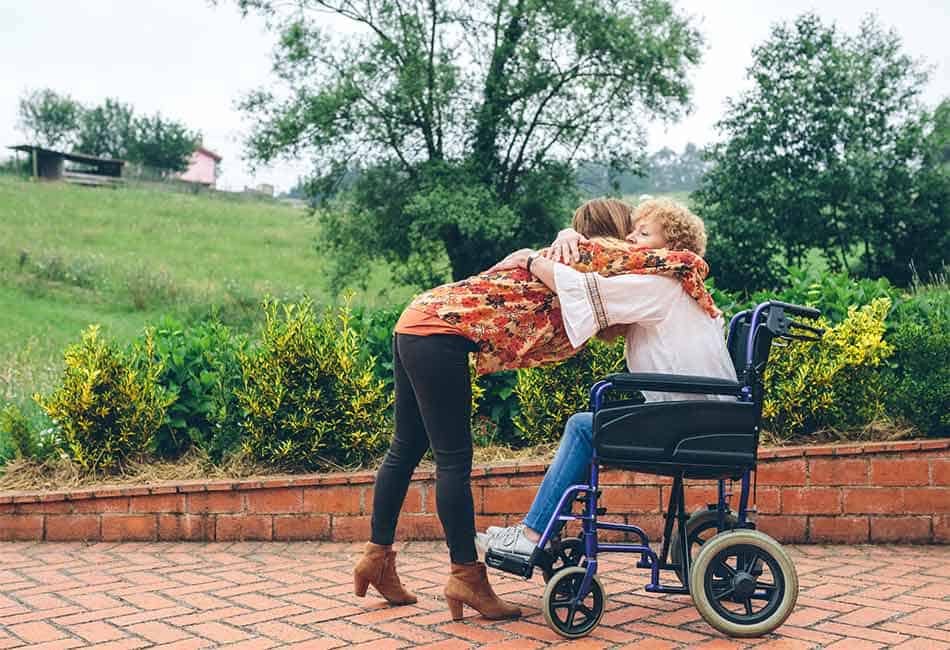
We have probably all heard that hugs are great for us as research shows they release oxytocin, the love hormone. But navigating the world of hugging in even the best of circumstances, like an exciting first date, can be awkward. It can be even more tricky when hugging someone in a wheelchair.
There are many ways you can comfortably and confidently hug someone in a wheelchair, whether from the side, back, or a full-on hug from the front. Before initiating a hug, you should always make sure it is welcome. For non-huggers, there are alternatives you can consider.
Giving thought to this matter ahead of time shows that you are loving and considerate, two characteristics that will likely make any hug you give a good one. But by having a game plan, you may be able to avoid any awkwardness when you find yourself in a position to hug someone in a wheelchair, whether it be a friend, family member, new romantic interest, or any other acquaintance.
Why You Should Give Consideration To Hugging Someone In A Wheelchair
The word hug is believed to have roots either from Old Norse, from the word hugga, meaning “to comfort,” or be derived from the German word hegen, meaning “to foster, cherish, to enclose with a hedge.”
According to research, hugs are beneficial in more ways than just comforting and showing that you cherish a person: they can reduce stress, protect against illness, boost heart health, make you happier, reduce your fears and pain, and help you communicate with others. These are positive effects that we could all stand to reap, and these benefits can perhaps be even more valuable to those in a wheelchair.
While we can all feel lonely and isolated at times, some groups of people are more susceptible to chronic loneliness than others. Those in wheelchairs may face even more obstacles to meaningful social interactions and building strong, lasting relationships. One study done in the United Kingdom showed that “half of disabled people say they are lonely, and one in four feel lonely every day.”
One cause of this increased loneliness may be due to people feeling unsure how to hug or otherwise greet or comfort someone in a wheelchair. This is a simple issue to resolve if you give it a little forethought.
Hugging Someone In A Wheelchair
Before giving a person in a wheelchair a hug, there are some things you should consider: whether or not they want to be hugged, how much mobility they have, and if there are any special considerations with their chair.
Do They Want To Be Hugged?
Not everyone is a big hugger; in fact, you probably have a friend or family member who is decidedly not a hugger. This should be taken into account with any person you attempt to hug, whether they are in a wheelchair or not. People have different personalities- ranging from Let’s Hug Everybody! to Do Not Touch Me. Get to know someone before deciding whether they want a hug from you.
Even people who are self-proclaimed “big huggers” have their moments or days where they don’t want to be touched. Always pay attention to a person’s body language or facial cues, and if you are still unsure, it’s never a bad idea to ask if you can give someone a hug.
Besides just disliking hugs, some wheelchair users may have issues with touch. A touch on the shoulder may be physically uncomfortable, while a hug may be excruciatingly painful for them. Or the person may have an issue with sensitivity to touch, and a hug may completely overwhelm them.
Touch may not be the only issue. If the person has a sensitivity to smell, your perfume or cologne at close proximity may be overpowering. Remember, you want your hug to put the person at ease, not make them more uncomfortable.
You should also consider how close you are with the person and how well you know them. Some people may love to hug family members or close friends, but may not be so keen on cozying up to an acquaintance.
And just like you would never go up to a stranger and hug them (unless you have their expressed permission), you should never go up to a stranger in a wheelchair and assume they want to be hugged. Unfortunately, many wheelchair users report this happening and attribute it to a feeling of pity and a need to comfort the wheelchair users.
But this article on ten things to avoid when meeting someone with a disability explains it best:
“Just because a person is differently abled to you it does not mean that they are in a worse situation, or in pain, or have no purpose in life and deserve your pity. Many people with disability lead a full active life and yes, they might endure pain, but they need understanding and acceptance rather than pity.”
How Much Mobility Do They Have?
How much mobility a person in a wheelchair has may affect how you can hug them, or whether they want to be hugged at all. Some people who suffer from limited or no mobility may already feel as if they have no autonomy over their own body. They may not like being hugged, or even touched.
A person with limited upper-body mobility may enjoy hugs, but you may have to do most of the work. If someone with full upper-body mobility makes no move towards you, then they may not be open to hugging.
What if you don’t know how much movement a person is capable of? You should never assume something about a person’s physical conditions, and odds are if you don’t know if the person has use of their arms or upper body, or even their legs (not all people in a wheelchair are unable to stand or walk), then you don’t know the person well enough to hug them, without at least asking permission first.
Does Their Chair Have Any Special Considerations?
Some wheelchairs may make it easier for its user to give or receive a hug, such as standing wheelchairs (with a lap belt rather than a bar at chest level). However, you may have to adapt your hug to a wheelchair.
For example, when hugging someone in a wheelchair with a robotic arm or other assistive technology, such as a mouth stick or head wand, you should be careful not to knock into the machinery. Look for the area with the most empty space and go in for a hug from that side. For those who use a mobility scooter, you may have to lean in between the seat and handlebars.
You should especially be careful not to touch a joystick or other mechanism that can move the wheelchair. No one will enjoy going for an unexpected ride, and the subsequent awkwardness will be painful.
How To Hug Someone In A Wheelchair
Always follow the lead of the person in the wheelchair. For instance, if they raise both arms to you, then you know they are comfortable with a full-contact hug from the front. If you are the person initiating the hug (and you are certain they want to be hugged), there are different types of hugs that can work well for a person in a wheelchair to give and receive.

Side Hug
For a brief hello hug or a hug between friends, a side hug may be your best bet. This works best if you are sitting in a chair next to the person in the wheelchair, but can also work by standing next to the chair and leaning over.
Using the arm closest to your friend, you would put your arm around their shoulders, resting your hand on the opposite shoulder. The other person may or may not do the same, placing their arm over your shoulders or around your back. You could both keep your bodies facing forwards, or you could twist briefly towards each other.
To increase the intimacy of this hug, you could rest your foreheads against each other, or even rest your head on the opposite person’s shoulder, depending on their height relative to yours when sitting.

Full-On Hug From The Front
For a general, all-purpose hug that can work for anyone from acquaintances to lovers, you can approach from the front by leaning over the wheelchair user, squatting in front of the chair, or sitting in a chair diagonal to the wheelchair.
Leaning forward, you would wrap both arms around the person, sliding your forearms and hands behind the person’s back. If that is not possible due to their condition, you can wrap your arms behind the back of the wheelchair. You should scoot in close to the person so they may wrap their arms around you, if they choose to do so.
The closeness of your relationship with the person should dictate how tightly you squeeze the person and whether you press your upper bodies together or maintain distance, as well as how long you hold the hug for. Depending on intimacy, you can rest your face against theirs, in the crook of their neck, or keep some space between you. For a more casual hug, you might pat the person’s back.

Hug From Behind
A hug from behind would work best for someone you are very close with, such as an immediate family member or a romantic partner. You would not want to make a person uncomfortable by hugging them from behind if you are not positive this type of greeting would be welcomed. This hug also may not work with certain types of wheelchairs, such as standing chairs with tall backs.
For this hug, you would stand behind the wheelchair and lean over with your head over one of the person’s shoulders, wrapping your arms around them. Your arms would come around the shoulders, with your hands meeting somewhere around the chest or stomach, depending on how far you lean over.
A person with use of their arms may reach up to hug you around the shoulders/neck area, or they could simply clasp your hands. You could also add tenderness to this hug by pressing your faces together cheek to cheek.
Other Things To Consider When Hugging Someone In A Wheelchair
Once you have confirmed you have a willing participant, and you have decided on how to hug your friend in a wheelchair, here are few things you should also consider.
Facial Expression And Body Language
If this is your first time hugging someone in a wheelchair, or hugging a particular wheelchair user, you may feel a little nervous. They may be nervous, as well. Try to make the hug as welcoming as possible by paying attention to your facial expression and body language.
Smile warmly, make eye contact, and use positive body language such as wide opened arms and a willingness to embrace. Use a gentle, yet firm touch. If you are genuine and loving in your motives for giving a hug, that will come across clearly to the other person.
Tightness And Duration Of The Hug
The enjoyableness of a hug will depend on how natural it feels. It should not be too long, nor too short. It should not be too tight, nor too loose. The best tip to find this sweet spot of hugging is to follow the other person’s lead. If they squeeze you tightly, you know that you can squeeze back. If they hold on for longer than a few moments, you can be sure they are enjoying the hug and can hold on until they let go.
If the person cannot participate in the hug due to their physical abilities, then err on the side of caution by giving a brief but firm hug. Exceptions to this would be if you are extremely close with the person and hug them often, or if you know that they are in need of comfort and a longer, more supportive hug.
Hugging A Significant Other
In new romantic relationships, you may be nervous about giving a more romantic hug to someone in a wheelchair. However, you should not question a person’s decisions about their body. For instance, if they say that they are comfortable with you sitting on their lap to hug, you should listen to them.
They may enjoy having you sit facing forward so that they can hug you from behind, perhaps resting their chin on your shoulder. Or they may like having you sit sideways on their lap with your arms around their neck or shoulders, or resting your head against their chest. Try not to repeatedly ask if you are ‘hurting’ them; they will let you know if the hug becomes uncomfortable.
When They Are Not In The Mood For A Hug
Sometimes a wheelchair user who is usually a hugger may not be in the mood for a hug, for whatever reason. If you go in for a hug and the person stiffens, turns away from you, or looks surprised or uncomfortable, you should immediately let go and step back. Try not to take it personally; the person may be in pain or may be feeling touched out.
Other Greetings For People In A Wheelchair
It is important to show kindness and consideration to a person, no matter what their physical abilities may be. If you are unsure of how to hug a person in a wheelchair, unsure of whether they want to be hugged, or just uncomfortable with hugging yourself, consider a different way of greeting:
- For those with upper-body mobility, you can shake hands.
- For those with arm movement but no hand mobility, try offering a modified shake by lightly grabbing the outside of their hand with one or both of your hands.
- For those with limited arm mobility, you can attempt to gently shake hands if they initiate it or offer a fist bump.
- For those with no arm movement, you can give a friendly smile and a nod.
Some wheelchair users will not mind a pat on the shoulder or hand, while others will not want to be touched. (Never pat an adult wheelchair user on the head; this is extremely disrespectful.) Some people in wheelchairs like it when others crouch or bend down to their level; others will find it condescending. Always observe the nonverbal cues of the person and follow their lead when possible.
Conclusion
Hugs are an important expression of affection in almost all cultures. They are used to greet friends, family members, and lovers; offer physical comfort or support; and demonstrate a strong, emotional connection between two people. Beyond just making a person feel happy, research also shows that hugging can have many health benefits.
Giving consideration to making sure that a person in a wheelchair feels comfortable when giving or receiving a hug shows thoughtfulness and kindness. But it is important to remember that hugs are about love and friendship and showing that you care, not about the perfect technique.
